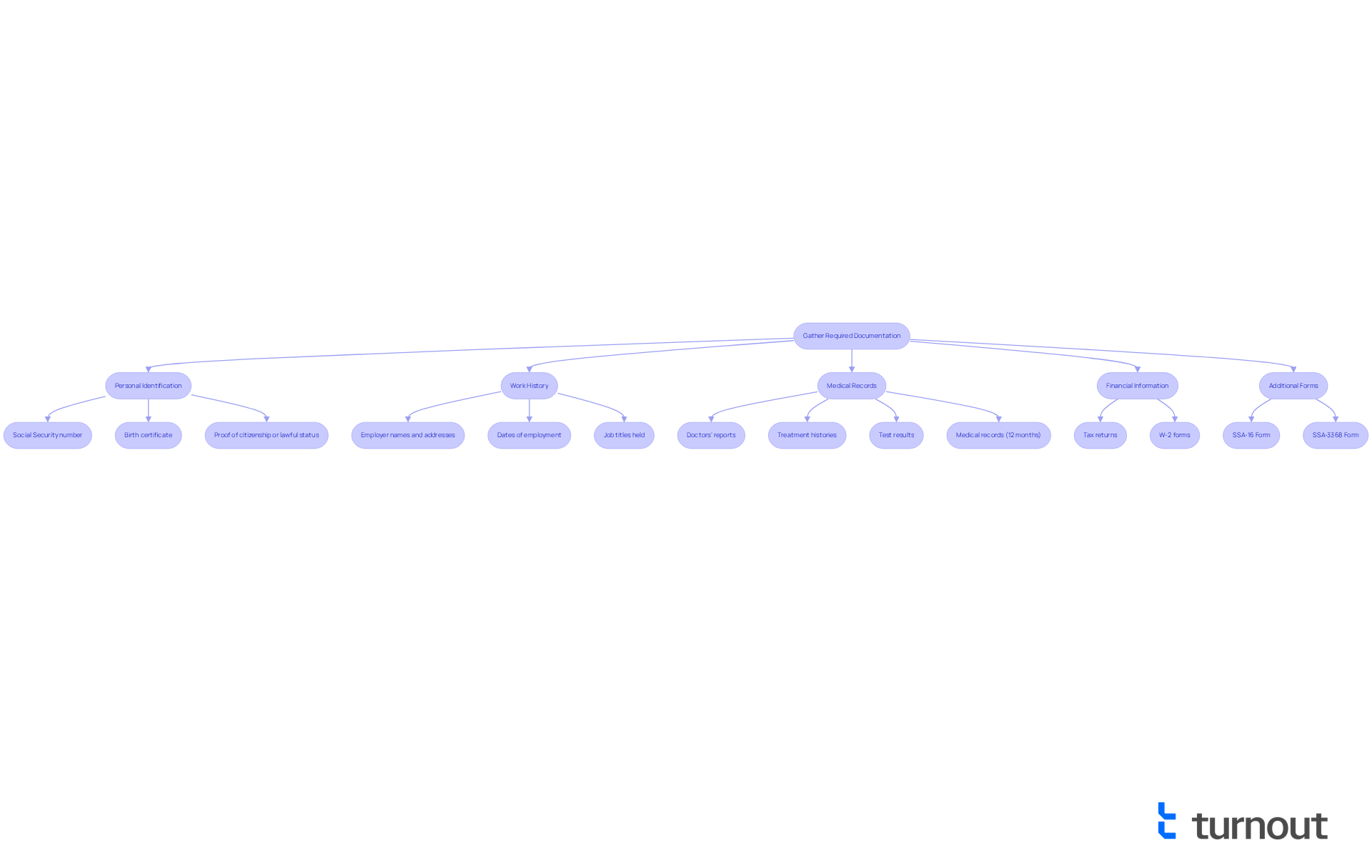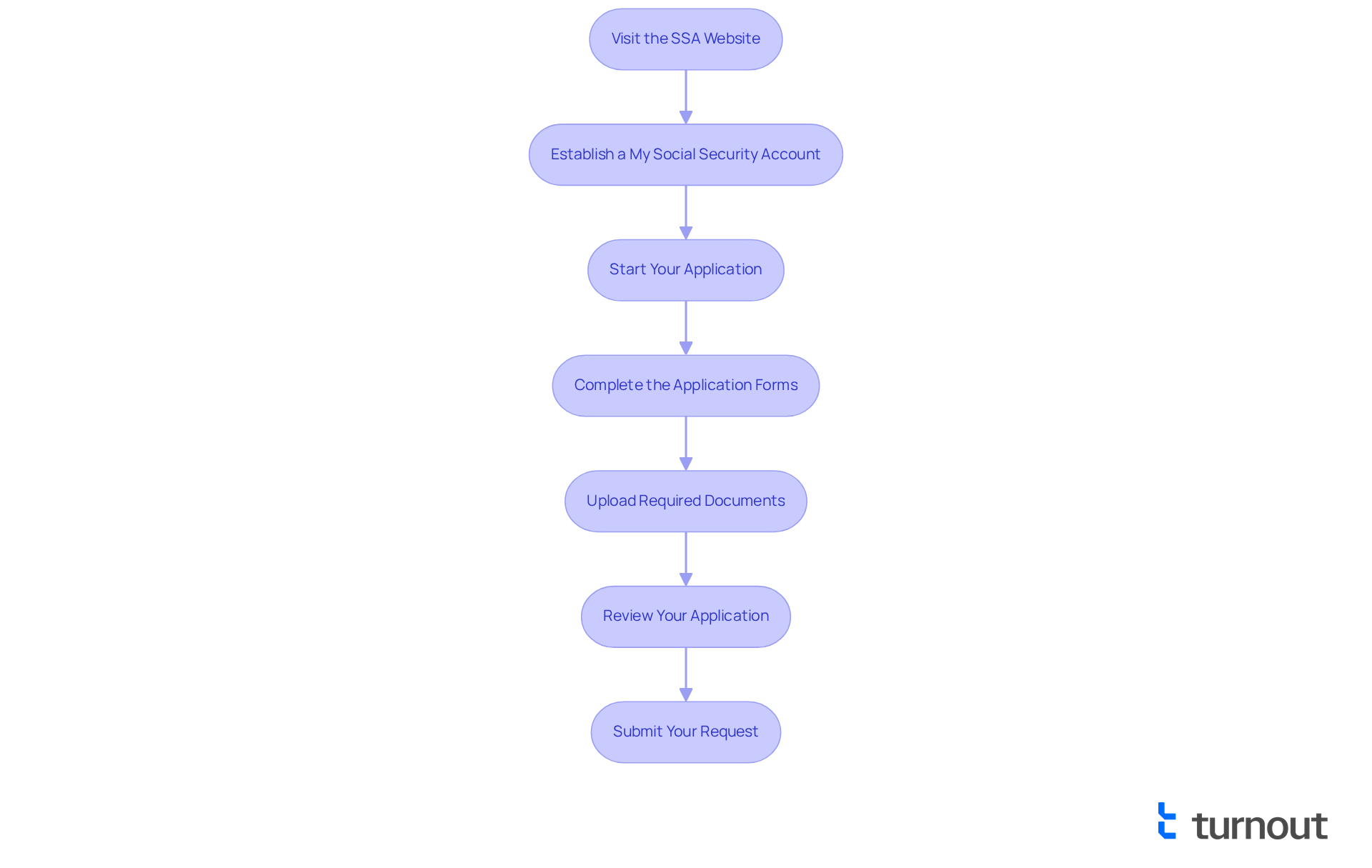Overview
Navigating the SSDI online application process can feel overwhelming, and we understand that. This article offers step-by-step guidance to help you master the application process, focusing on:
- Eligibility criteria
- Required documentation
- Common troubleshooting issues
Preparation is key. Many applications face denial due to incomplete documentation or technical errors. By being thorough and accurate, you can significantly enhance your chances of approval. Remember, you are not alone in this journey; we’re here to help you every step of the way.
Take a moment to reflect on your own experiences. Have you ever felt lost in the application process? It’s common to feel that way, but with the right information and support, you can navigate through it successfully. Together, we can work towards achieving your goals.
Introduction
Navigating the process of applying for Social Security Disability Insurance (SSDI) can often feel overwhelming, like wandering through a labyrinth of requirements and documentation. We understand that approximately two-thirds of initial applications face denial, making it crucial to grasp the eligibility criteria and gather the necessary paperwork for success.
This article serves as a compassionate guide, offering a step-by-step approach to mastering the SSDI online application. Here, we highlight essential tips and troubleshooting strategies designed to significantly enhance your chances of approval.
What key challenges do you face as an applicant, and how can you effectively overcome them to secure the benefits you deserve? Remember, you are not alone in this journey, and we're here to help you every step of the way.
Understand SSDI: Purpose and Eligibility Criteria
Disability Insurance is designed to provide financial support for individuals unable to work due to an eligible disability. We understand that navigating the SSDI online application process can feel overwhelming, so let’s break down the key eligibility criteria for Social Security Disability Insurance (SSDI).
-
Work History: To qualify, you need to have held jobs covered by social insurance and earned enough work credits. Typically, this means working for at least 5 of the last 10 years. In 2025, individuals must earn at least $7,240 to gain the maximum four credits, with each credit requiring $1,810 in covered earnings.
-
Disability Definition: Your disability must align with the Social Security Administration's (SSA) strict definition. This includes being unable to engage in substantial gainful activity (SGA) due to a medical condition expected to last at least 12 months. For 2025, the SGA threshold is set at $1,620 for non-blind individuals and $2,700 for statutorily blind individuals.
-
Medical Evidence: Comprehensive medical documentation is essential to support your disability claim. This includes records that illustrate the severity and duration of your condition.
Grasping these criteria is vital, especially since around two-thirds of initial SSDI online applications are denied, often due to insufficient work history or medical evidence. It’s also important to note that the SSA regularly updates its list of impairments that automatically qualify individuals for benefits, which could impact your eligibility.
By ensuring you meet the work history requirements and preparing the necessary documentation for your SSDI online application, you can significantly boost your chances of a successful submission. Remember, seeking guidance from a disability lawyer or your local SSA office can be incredibly beneficial during this process. And if your request is denied, know that you have the right to appeal the decision. You are not alone in this journey; we’re here to help.

Gather Required Documentation for Your Application
Before you begin your ssdi online application, we understand that it can feel overwhelming to gather the right documents. However, taking the time to collect the following items can significantly enhance your chances of approval:
- Personal Identification: Make sure to include your Social Security number, birth certificate, and proof of U.S. citizenship or lawful alien status.
- Work History: Compile a detailed work history, listing the names and addresses of your employers, dates of employment, and job titles held.
- Medical Records: Assemble all pertinent medical documentation, such as doctors' reports, treatment histories, and test results that support your disability claim. Remember, medical documents should cover a minimum of 12 months to demonstrate the persistence and severity of your condition.
- Financial Information: Prepare your tax returns, W-2 forms, and any other financial documents to illustrate your income history.
- Additional Forms: Be ready to complete specific forms, including the SSA-16 (Application for Disability Insurance Benefits) and the SSA-3368 (Adult Disability Report).
Collecting these documents not only simplifies your ssdi online application process but also greatly enhances your chances of approval. It's common to feel anxious about incomplete documentation, as this is a primary reason for delays and denials in disability applications. Thorough preparation is crucial. Statistics show that applicants who submit their ssdi online application with comprehensive documentation enjoy a higher approval rate, which underscores the importance of being meticulous in this phase.
As Jake, our AI case Quarterback, wisely advises, "Start gathering the necessary evidence for Social Security Disability Insurance promptly to avoid delays and enhance your chances of approval." Additionally, remember to keep records of all submitted documents and correspondence with the SSA. You're not alone in this journey; we're here to help ensure a smooth process moving forward.

Navigate the Online Application Process for SSDI
The ssdi online application process can feel overwhelming, but we're here to guide you through each step with care and understanding. Follow these steps to make the process smoother:
- Visit the SSA Website: Begin by navigating to the Administration's official site at www.ssa.gov/disability. This is your starting point for assistance.
- Establish a My Social Security Account: If you don’t have an account yet, take a moment to set one up. This account is essential for managing your request and monitoring its status, ensuring you have access to your information.
- Start Your Application: Click on 'Apply for Disability' and select 'Start Application' to begin your journey.
- Complete the Application Forms: Carefully fill out the required forms, including the SSA-16 and SSA-3368. It's important to be thorough and consistent in your answers, as inaccuracies can lead to delays or denials. In fact, approximately 43% of initial requests were denied due to technical issues in 2021, underscoring the importance of careful completion.
- Upload Required Documents: Attach necessary documentation, such as medical records and identification. Ensure that all documents are clear and legible to avoid processing delays.
- Review Your Application: Before submitting, take a moment to review all information for accuracy and completeness. This step is crucial, as missing information can lead to longer wait times. As of November 2023, the average wait time for a decision on a disability request was 7 months and 15 days.
- Submit Your Request: Once everything is in order, submit your request. You will receive a confirmation number for your records, which is essential for monitoring your status.
By following these steps, you can help ensure that your ssdi online application is completed accurately and efficiently. Remember, you are not alone in this journey, and taking these actions enhances your chances of a positive result in a system where the national approval rate for initial submissions was around 38%. We're here to help you every step of the way.

Troubleshoot Common Issues During Your SSDI Application
Navigating the SSDI online application process can be challenging, and we understand that you may feel overwhelmed. Here’s how to effectively troubleshoot some common issues you might encounter:
-
Missing Information: If you find out that your submission is incomplete, take a moment to carefully review the checklist of required documents. Ensuring that all necessary information is accurately provided can help you avoid delays and ease your worries.
-
Technical Difficulties: Should you experience problems with the online submission portal, consider clearing your browser cache or switching to a different browser. If issues persist, don’t hesitate to reach out to SSA technical support for assistance. Additionally, if you cannot verify your identity online, remember that you can complete your claim over the phone.
-
Delays in Processing: If your request is taking longer than expected, you have options. You can check its status online via your My Social Security account or contact the SSA directly for updates. As of early 2025, the average wait time for an initial decision is approximately 232 days, with over 1 million claims pending. This highlights the urgency of addressing any issues related to your submissions.
-
Denial of Benefits: In the event of a denial, it’s important to carefully examine the denial letter to understand the reasons behind it. You have the right to appeal the decision by following the instructions outlined in the letter. Claimants who file timely appeals often improve their chances of securing benefits. In fact, national data shows that claimants with representatives receive benefits at a rate three times higher than those without.
By being proactive and prepared for these common issues, you can navigate the SSDI online application more effectively. Remember, you are not alone in this journey, and we’re here to help you increase your likelihood of success.

Conclusion
Mastering the SSDI online application process is essential for those seeking financial support due to disabilities. We understand that this journey can feel overwhelming. This guide has provided a comprehensive overview of the eligibility criteria, documentation requirements, and step-by-step instructions to navigate the application with confidence. By understanding the intricacies of the SSDI system, you can enhance your chances of a successful outcome.
Key points discussed include:
- The importance of meeting work history requirements
- The need for thorough medical documentation
- The careful completion of application forms
It's common to feel uncertain about these requirements, but knowing how to troubleshoot common issues and understanding the appeal process can empower you to overcome potential obstacles. Each of these elements plays a significant role in ensuring that you submit a strong application that meets the SSA's stringent standards.
Ultimately, the journey toward securing SSDI benefits can be complex, but it is navigable with the right preparation and support. Taking proactive steps, gathering comprehensive documentation, and being informed about the process can greatly increase your likelihood of approval. Remember, you are not alone in this endeavor. We encourage you to reach out for guidance; embracing the resources available can lead to a smoother application experience and ultimately provide the financial relief needed during challenging times.
Frequently Asked Questions
What is the purpose of Social Security Disability Insurance (SSDI)?
SSDI provides financial support for individuals who are unable to work due to an eligible disability.
What are the work history requirements to qualify for SSDI?
To qualify, you must have held jobs covered by social insurance and earned enough work credits, typically working for at least 5 of the last 10 years. In 2025, you need to earn at least $7,240 to gain the maximum four credits, with each credit requiring $1,810 in covered earnings.
How does the Social Security Administration (SSA) define disability?
The SSA defines disability as being unable to engage in substantial gainful activity (SGA) due to a medical condition expected to last at least 12 months. For 2025, the SGA threshold is $1,620 for non-blind individuals and $2,700 for statutorily blind individuals.
What type of medical evidence is required for an SSDI claim?
Comprehensive medical documentation is essential, including records that illustrate the severity and duration of your condition.
Why are many SSDI applications denied?
Around two-thirds of initial SSDI online applications are denied, often due to insufficient work history or medical evidence.
How can I improve my chances of a successful SSDI application?
Ensure you meet the work history requirements and prepare the necessary documentation for your SSDI online application. Seeking guidance from a disability lawyer or your local SSA office can also be beneficial.
What should I do if my SSDI application is denied?
If your request is denied, you have the right to appeal the decision. Support is available to help you through this process.




